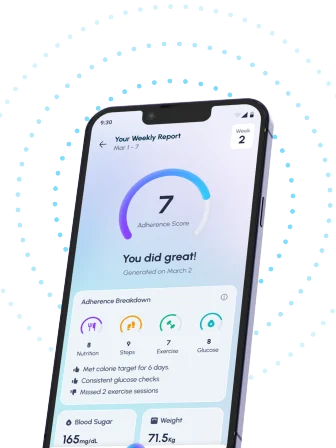Table of Contents
- Understanding Glucagon’s Role in Prediabetes
- Glucagon and Glucose Metabolism: A Prediabetes Overview
- How Glucagon Affects Blood Sugar in Prediabetic Individuals
- Managing Glucose with Glucagon: A Prediabetes Guide
- Prediabetes and Glucagon: Improving Metabolic Control
- Frequently Asked Questions
- References
Are you concerned about prediabetes and its impact on your blood sugar levels? Understanding how your body regulates glucose is crucial for managing this condition, and a key player in that process is glucagon. This blog post delves into Glucagon’s Impact on Glucose Metabolism in Prediabetes: A Comprehensive Study, exploring its role in maintaining healthy blood sugar and offering insights into potential strategies for improved metabolic control. We’ll examine the latest research and break down the complex science in a clear, easy-to-understand way. Get ready to learn how this often-overlooked hormone might be the key to better managing your prediabetes.
Understanding Glucagon’s Role in Prediabetes
The Counter-Regulatory Hormone
Prediabetes, characterized by fasting blood sugar levels between 100–125 mg/dL (compared to the normal range of 70–99 mg/dL), represents a critical stage where glucose metabolism is significantly altered. Understanding this imbalance is key to effective management. Central to this process is glucagon, a hormone produced by the pancreas that plays a crucial counter-regulatory role to insulin. While insulin lowers blood glucose, glucagon raises it, primarily by stimulating the liver to release stored glucose into the bloodstream. In prediabetes, this delicate balance is disrupted.
Glucagon’s Imbalance in Prediabetes
In individuals with prediabetes, insulin resistance often occurs. This means cells don’t respond effectively to insulin, leading to higher blood glucose levels. The body attempts to compensate by producing more insulin, but this can eventually lead to a relative glucagon excess. This excess glucagon further contributes to elevated blood sugar, creating a vicious cycle that accelerates the progression towards type 2 diabetes. This is particularly relevant in tropical and Indian populations, where genetic predispositions and lifestyle factors often interact to influence glucose metabolism.
Managing Glucagon’s Impact
Effective management of prediabetes involves lifestyle modifications that indirectly influence glucagon levels. A balanced diet low in refined carbohydrates and high in fiber can help prevent sudden spikes in blood glucose, thus reducing the need for excessive glucagon release. Regular physical activity improves insulin sensitivity, indirectly mitigating the effects of glucagon excess. Consulting a healthcare professional is crucial for personalized advice and monitoring, especially in individuals residing in regions like India and other tropical countries, where specific dietary and lifestyle considerations are paramount for effective prediabetes management. Early intervention is key to preventing the progression to type 2 diabetes. For more information on specific strategies, you might find our article on How to Reverse Prediabetes? helpful. Understanding the Prediabetes Range: What You Need to Know is also crucial for effective self-management.
Glucagon and Glucose Metabolism: A Prediabetes Overview
Maintaining healthy blood glucose levels is crucial, especially in prediabetes, a condition where blood sugar is higher than normal but not yet high enough to be diagnosed as type 2 diabetes. Understanding the role of glucagon in this process is key. Glucagon, a hormone produced by the pancreas, acts as a counter-regulatory hormone to insulin. While insulin lowers blood glucose levels by facilitating glucose uptake into cells, glucagon raises blood sugar levels by stimulating the liver to release stored glucose (glycogenolysis) and produce new glucose (gluconeogenesis). This balance is vital for maintaining euglycemia, or normal blood sugar.
The Prediabetes Connection
In prediabetes, this delicate balance can be disrupted. Insulin resistance, a hallmark of prediabetes, means cells don’t respond effectively to insulin, leading to higher blood glucose levels. Consequently, the body may overproduce glucagon to compensate, further exacerbating the problem and potentially pushing blood sugar levels even higher. This highlights the importance of managing both insulin and glucagon activity in prediabetes management. Ideally, pre-meal blood sugar should fall between 80–130 mg/dL, and post-meal levels should remain below 180 mg/dL. Exceeding these ranges consistently increases the risk of progressing to type 2 diabetes. Learning more about reversing prediabetes is crucial, and you can find helpful strategies in our article, Can I Reverse Prediabetes? Effective Strategies for a Healthier Future.
Regional Considerations in India and Tropical Countries
In India and other tropical countries, lifestyle factors like dietary habits rich in carbohydrates and a lower level of physical activity can contribute significantly to prediabetes. Managing glucagon’s influence on blood sugar requires a holistic approach that includes dietary modifications, regular exercise, and potentially medication under a doctor’s guidance. Consult your physician or a registered dietitian to develop a personalized plan tailored to your specific needs and cultural context. Regular monitoring of blood sugar levels is also essential. Early intervention is key to preventing the progression from prediabetes to type 2 diabetes. As you age, managing diabetes presents unique challenges; Managing Diabetes as You Age: Challenges and Solutions offers valuable insights.
How Glucagon Affects Blood Sugar in Prediabetic Individuals
Prediabetes, a condition characterized by higher-than-normal blood sugar levels, affects a significant portion of the population in India and other tropical countries. Understanding how hormones like glucagon influence glucose metabolism is crucial for effective management and prevention of type 2 diabetes. Glucagon, a hormone produced by the pancreas, plays a counter-regulatory role to insulin. While insulin lowers blood sugar, glucagon raises it by stimulating the liver to release stored glucose into the bloodstream. This process is vital for maintaining blood glucose balance during periods of fasting or low blood sugar.
Glucagon’s Role in Prediabetes
In prediabetic individuals, the balance between insulin and glucagon can be disrupted. This imbalance can lead to increased blood glucose levels, further increasing the risk of progressing to type 2 diabetes. The body’s reduced sensitivity to insulin (insulin resistance), common in prediabetes, means that glucagon’s effects on glucose release become more pronounced, exacerbating the problem. This is especially concerning considering that daily consumption of sugary beverages raises diabetes risk by 26%, a statistic particularly relevant in many regions of India and other tropical countries with high rates of sugary drink consumption. Understanding Blood Sugar Levels is key to managing this condition.
Managing Glucagon’s Influence
Effective management of prediabetes requires a holistic approach focusing on lifestyle modifications. A balanced diet low in refined carbohydrates and sugars, regular physical activity, and maintaining a healthy weight are crucial in improving insulin sensitivity and mitigating the impact of glucagon on blood sugar levels. Prioritizing whole grains, lean proteins, and plenty of fruits and vegetables can help regulate blood glucose levels more effectively. For example, managing Why Blood Sugar Spikes in the Morning and How to Manage Them can be a significant step in overall blood sugar control.
Seeking Expert Advice
For individuals in India and tropical countries with prediabetes, consulting a healthcare professional is paramount. Early intervention and personalized management strategies are key to preventing the progression to type 2 diabetes. Regular blood sugar monitoring and working closely with a doctor or certified diabetes educator can help tailor a plan to manage your blood sugar levels effectively, considering the specific role of glucagon in your body’s response to glucose.
Managing Glucose with Glucagon: A Prediabetes Guide
Prediabetes, characterized by fasting blood glucose levels between 140–199 mg/dL, affects a significant portion of the population in India and other tropical countries. Understanding how your body regulates glucose is crucial for managing this condition and preventing the progression to type 2 diabetes. Glucagon plays a vital role in this process.
Glucagon’s Role in Glucose Metabolism
Unlike insulin, which lowers blood glucose, glucagon acts as a counter-regulatory hormone, raising blood sugar levels when they fall too low. This is particularly important during periods of fasting or intense physical activity. In prediabetes, while insulin resistance might be present, the body still relies on glucagon to maintain glucose homeostasis. Understanding this balance is key to making informed lifestyle choices.
Practical Strategies for Prediabetes Management in Tropical Climates
Given the prevalence of prediabetes in hot and humid climates like those found across India and other tropical regions, managing your diet and lifestyle becomes even more critical. Regular exercise, particularly in the cooler parts of the day, is essential. Focusing on a diet rich in fiber, fruits, and vegetables— readily available in many tropical areas—can help regulate blood sugar levels naturally. Regular monitoring of blood glucose levels is also recommended to track progress and make necessary adjustments to your diet and exercise plan. Consult a healthcare professional for personalized advice and to discuss medication if necessary. Managing your cholesterol is also important, so check out our guide on How to Manage Cholesterol Levels with Diabetes? for additional tips.
Seeking Expert Advice in India and Tropical Countries
Early intervention is crucial in prediabetes management. Consult a doctor or certified diabetes educator in your region for a personalized plan. They can assess your individual risk factors and guide you toward appropriate dietary and lifestyle modifications. Taking proactive steps today can significantly reduce your risk of developing type 2 diabetes and improve your overall health and well-being. For more comprehensive strategies, see our guide on 10 Proven Tips to Effectively Manage Diabetes | Simple Guide.
Prediabetes and Glucagon: Improving Metabolic Control
Prediabetes, a condition characterized by higher-than-normal blood sugar levels, significantly increases the risk of developing type 2 diabetes (T2D). Individuals with prediabetes face a concerning 5-10% annual risk of progressing to T2D, a statistic amplified in populations across India and other tropical countries due to lifestyle factors and genetic predispositions. Research highlights the crucial role of glucagon in this metabolic imbalance.
Understanding Glucagon’s Role
Glucagon, a hormone produced by the pancreas, counteracts the effects of insulin. While insulin lowers blood glucose levels, glucagon raises them by stimulating the liver to release stored glucose. In prediabetes, this delicate balance is often disrupted. The body may overproduce glucagon or become less responsive to insulin’s glucose-lowering effects. This leads to persistently elevated blood sugar, further increasing the risk of developing T2D. Effective management of prediabetes hinges on understanding and addressing this hormonal interplay.
Strategies for Metabolic Control
Managing glucagon’s impact requires a multifaceted approach. A balanced diet low in refined carbohydrates and high in fiber is crucial. This helps to prevent sudden spikes in blood glucose and reduces the burden on the pancreas to produce insulin and regulate glucagon. Regular physical activity, tailored to individual needs and preferences, is also essential for improving insulin sensitivity and enhancing glucose metabolism. In India and other tropical regions, integrating traditional practices like mindful eating and incorporating locally sourced, nutrient-rich foods can further support healthy glucose control. Supporting a healthy gut microbiome is also important, and you can learn more about how prebiotics and probiotics can help manage diabetes and enhance gut health.
Taking Action
Early intervention is key to preventing the progression from prediabetes to T2D. Consult a healthcare professional for personalized guidance on dietary adjustments, exercise plans, and monitoring blood glucose levels. By understanding the interplay between glucagon and glucose metabolism, and implementing lifestyle changes, individuals with prediabetes in India and tropical countries can significantly reduce their risk of developing T2D and improve their overall health outcomes. Maintaining a strong immune system is also crucial, and you may find helpful information on boosting immunity while managing diabetes. Don’t wait – take control of your metabolic health today.
Frequently Asked Questions on Glucagon’s Impact on Glucose Metabolism in Prediabetes: A Comprehensive Study
Q1. What is prediabetes and how does it relate to glucagon?
Prediabetes is a condition where your blood sugar levels are higher than normal but not yet high enough to be diagnosed as type 2 diabetes. Glucagon, a hormone, works opposite to insulin, raising blood sugar. In prediabetes, your body doesn’t use insulin effectively (insulin resistance), leading to increased glucagon production, which further elevates blood sugar.
Q2. What are the main ways to manage prediabetes?
Managing prediabetes focuses on lifestyle changes. These include eating a balanced diet low in refined carbohydrates and high in fiber, getting regular exercise to improve insulin sensitivity, and regularly monitoring your blood sugar levels.
Q3. Why is managing prediabetes particularly important for people in tropical and Indian populations?
People in tropical and Indian populations may have a higher risk of prediabetes due to genetic factors and lifestyle influences. Effective management is crucial to prevent progression to type 2 diabetes.
Q4. What are the potential long-term consequences if prediabetes is left untreated?
If left unmanaged, prediabetes can progress to type 2 diabetes, increasing your risk of serious health problems like heart disease, stroke, kidney disease, and nerve damage.
Q5. When should I consult a healthcare professional about prediabetes?
You should consult a healthcare professional if you have been diagnosed with prediabetes or are concerned about your risk factors. They can provide personalized advice, recommend appropriate testing, and help you create a management plan to prevent progression to type 2 diabetes.
References
- Blood Glucose Level Prediction in Type 1 Diabetes Using Machine Learning: https://arxiv.org/pdf/2502.00065
- A Practical Guide to Integrated Type 2 Diabetes Care: https://www.hse.ie/eng/services/list/2/primarycare/east-coast-diabetes-service/management-of-type-2-diabetes/diabetes-and-pregnancy/icgp-guide-to-integrated-type-2.pdf




